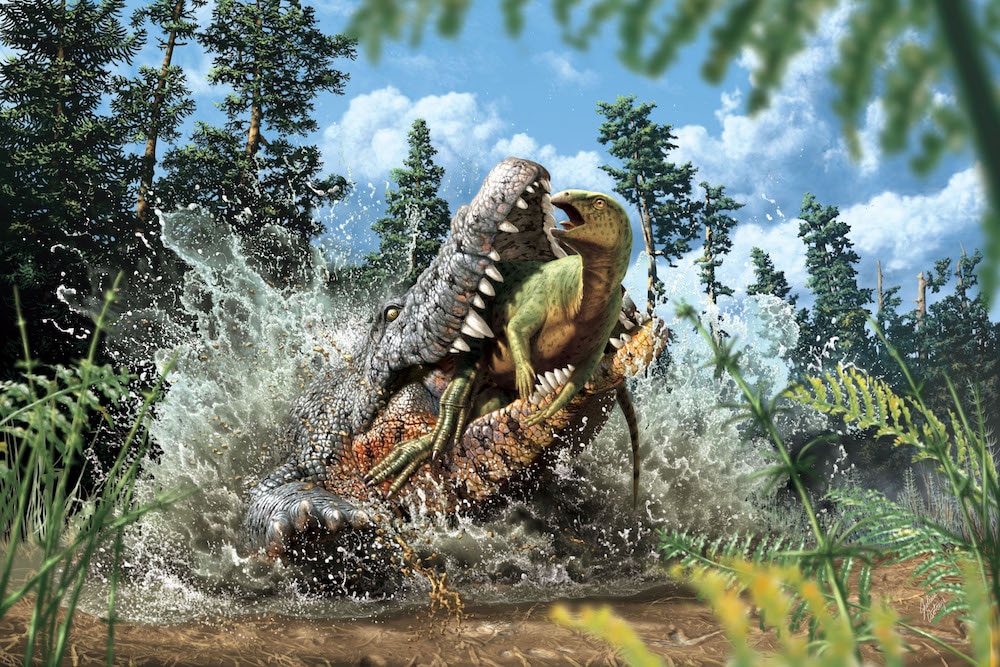Create a free profile to get unlimited access to exclusive videos, sweepstakes, and more!
This killer Cretaceous croc literally ate an entire dinosaur
Crikey, that's quite a bite.

You might think of dinosaurs (at least the theropods) as the apex predators to end all apex predators, but not if one got snapped up by the jaws of a massive crocodile first.
Confractosuchus sauroktonos lurked in the rivers of what is now Queensland, Australia about 95 million years ago. It is thought to have been an ambush predator much like extant crocodiles that stalk prey and then strike when their next meal is least expecting it. When the fossil of this newly discovered species of extinct crocodilian surfaced, something no one had been waiting for emerged from its gut cavity. It had apparently been digesting the remains of a dinosaur.
This beast may have not been the only croc feasting on dinosaurs — “terror crocodile” Deinosuchus had banana-size teeth that could potentially take down a carnivorous theropod — but it is the most obvious. Never before have the remains of a prehistoric crocodilian been found with evidence of a dino-sized meal where its stomach would have been. Paleontologist Matt White of the University of New England in Australia led a study recently published in Gondwana Research.
“One of the bones had a tooth puncture mark preserved on the femur,” he told SYFY WIRE. “But crocodiles do not discriminate when it comes to what they eat, whether it’s a rotting carcass or an animal that gets too close to the water’s edge.”
That bite mark was the evidence White was looking for to be sure Confractosuchus had really chewed up and swallowed a dinosaur. The ornithopod dinosaur in question may or may not be a new species. Its slender bones and overall smaller size might indicate a juvenile, but there are too many unknowns for anyone to name it yet. Skeletal remains of the unfortunate ornithopod include vertebrae, a femur from each leg, and a tibia, are assumed, at least for now, to have come from one individual, but the abdominal cavity suffered damage that might have destroyed more evidence forever.
How the dinosaur was digested probably didn’t help much with preservation, either. Crocodile stomachs are acidic enough to break down bone. They have more stomach acid than any other vertebrate alive, and the enzymes in that acid don’t mess around when it comes to dissolving every last trace of prey. Confractosuchus is not thought to have been a dinosaur specialist, and neither is its larger relative Deinosuchus, but that does’t mean it didn’t take advantage when it was hungry and a tasty reptile came wandering too close to resist.
“We compared the skull shape with modern crocodiles and determined that it resembled modern saltwater crocodiles, those that can bring down prey larger than themselves, but any size prey could have been targeted by Confractosuchus,” White said.
This predator (which was probably also a scavenger) belongs to Eusuchia, a group which encompasses the most recent common ancestor of crocodilians and all of that ancestor’s descendants. Most first emerged during the Cretaceous and took all sorts of different forms. Though now extinct, herbivorous crocodilians were once a thing. Most extant eusuchians haven’t changed much since then. While not exactly living fossils, you could think of them as time travelers from the distant past.
Remains of the ornithopod in the gut of Confractosuchus were found to have obvious evidence of chewing, dismemberment and bone fragmentation consistent with extant crocodilian feeding and digestion. It was probably capable of the infamous crocodile “death roll” used by crocs to dismember larger prey, though whether it ate anything larger than its last meal remains unknown.
“If potential prey was in the size range that it could consume, then it was likely targeted,” said White. “Hence, Confractosuchus it would have eaten anything it could capture.”


























